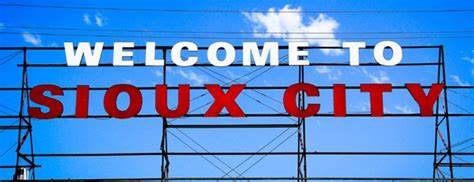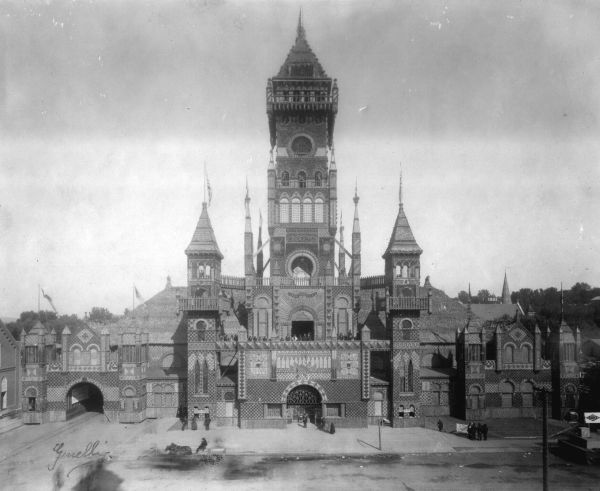I originally wrote about Sioux City’s Corn Palaces back in January of 2019, but I’d like to revisit them for this years month of March. We are focusing on Sioux City’s history, and calling it
I originally wrote about Sioux City’s Corn Palaces back in January of 2019, but I’d like to revisit them for this years month of March. We are focusing on Sioux City’s history, and calling it “History March”.
We will be looking at Central High, Downtown Sioux City, Jolly Time, and more! Enjoy, and I hope you enjoy learning as much about Sioux City as I have.
The first corn palace in the world!
You’ve most likely heard of the corn palace in Mitchell, South Dakota, but did you know Sioux City had the first corn palace? From 1887 to 1891 people from all over the United States came to see our plentiful crop on display.
To learn about our once famous corn palaces, I made my way to the Lewis and Clark Interpretive Center, and did you know they have a library of books specifically written about Sioux City?! So, one morning, I sat down with one of these books, and captured some photos.
history at high noon
Additionally, I learned about these corn palaces when I sat in on a lecture at the downtown Sioux City Public Museum on Thursday, September 20th, 2018. Once a month the downtown museum has a History at High Noon lecture about Sioux City and the surrounding areas. This day was about our corn palaces. I was so excited to learn about these ornate structures. I brought my notebook, and here is what I learned.
1887 Corn Palace
In 1870 the railroad came to Sioux City, with the union depot located on 2nd and Nebraska. This location is critical since all of the corn palaces were built close by the railroad depot. By 1883 over 50 trains arrived per day on 4 railway lines.
In the late 19th century, Sioux City was among several Iowa towns wanting to create something that would generate interest and tourism. Sioux City was experiencing exciting growth, and aspiring to increase the city’s popularity, investors and leaders wanted to celebrate. What better way, than with the most bountiful crop accessible to them: Corn.
The Corn Palace Committee was created in 1887, with W.E. Loft hired as their architect. The wooden structure was built on the corner of Fifth and Jackson Streets. Ears of brightly colorful Indian corn decorated every inch of the exterior. Fancy patterns and framed scenes adorned the outside. Windows and archways, and even the roof was embellished.
Creativity was not lost to the interior. The Corn Palace committee invited the women of Sioux City to design and decorate every room. The ladies fashioned a goddess of grain at the top of the golden stairway, a map of the United States and various murals covering every wall.
Along with the first corn palace, women would eventually be credited as decorating and embellishing the insides of the next four corn palaces. Each year the group of ladies increased, as the need for more elaborate detail grew.
The first picture are actual artifacts from various corn palaces in the late 1880s, and the second is a snapshot of what the corn pattern would have looked like. Both pictures were taken at the Downtown Sioux City Museum.
Local businesses even got involved. Storefronts, street lights and intersections were decked out with cornhusks, sorghum and even cattails. Corn “bead” necklaces and cornhusk hats were worn and corncob pipes were smoked.
With a crew of 46 workmen it took 6 days to build, using 20,000 bushels of corn. It would eventually be 210 feet long by 100 feet wide, with a 100-foot tower. Since the railroad was not utilized for this first corn palace, shipments took 15 days to arrive from nearby farms via 10 horse-drawn wagon teams.
Finally, on October 3rd, 1887 the Corn Palace Festival opened, and lasted 5 days. There were speeches, dances, parades concerts and fireworks. Festival attendance was above and beyond expected. Nearly 140,000 people attended, including the sitting President Grover Cleveland. Attendance alone almost quadrupled Sioux City’s population of 30,000!
Overall the 1887 Corn Palace cost $25,000. In today’s money that would be almost $693,000!
In later years, nationally known bands would travel to entertain palace-goers. Local business men and investors were ready to advertise Sioux City as the Corn Palace City.
1888 Corn Palace
Bigger and better was as promised! Built at a new site on the corner of Sixth and Pierce, the 1888 Corn Palace was more spectacular than the first. More ornate festivals and much higher attendance: 350,000 people this year!
A special train was even decorated this year to promote Sioux City, and its new slogan “Corn is King”. The train carried passengers to Chicago and even Washington DC, where they attended President Benjamin Harrison’s inauguration. The New York Times even did an article on the train: “Everything used in the decorations except the iron nails is the product of Iowa cornfields and the whole train is a marvel of beauty.”
1889 Corn Palace
Each year’s corn palace was greater than the last. The 1889’s corn palace did not disappoint. It featured a main tower 200 feet high, and a workforce of 269 women were charged to design the interior.
Electricity had only been invented ten years earlier, and most households did not have this new technology. However, no expense was spared for the greatest tourist attraction Sioux City had ever witnessed. What a marvelous sight it would have been to see this structure lit up at night.
1890 Corn Palace
Growing in size from the previous year, this corn palace, along with one 200-foot tall tower, showcased six 100-foot tall towers as well. According to the Sioux City Journal, there was a miniature valley, “and from far distant mountains clothed in pines came a stream of water, leaping over rocks, winding across a meadow, and falling into a lake below where palmettos were growing”.
1891 Corn Palace
This was the grandest of them all. Straddling Pierce Street, it featured an archway to allow traffic to pass through and a 200-foot tall tower just as the last two. The ladies of the Lilac History Club of Sioux City designed a library room. According to the Sioux City Journal, “The walls were covered with corn pictures and the floor with a grass rug. On a tiny table stood quill pens crafted from cane and oat straws. A corn lamp, gourd inkwell and cornhusk blotter completed the setting”.
However, attendance was down due to the cold weather and drizzly days, and by the next year the Great Floyd River Flood of 1892 devastated most of Sioux City. With city money being put towards rebuilding neighborhoods and businesses, there was not enough left over to construct a corn palace that year. Plus, residents thought it reckless to expect investors and volunteers to construct and design a corn palace after such a city-wide tragedy.
Mitchell, SD
Sioux City was on track to build a corn palace in 1893, but businessmen, along with the entire nation, could not have predicted the economic depression that affected every sector of the economy. Local Sioux City banks and businesses failed due to the weakened economy. In addition, as soon as business owners in Mitchell, South Dakota heard that Sioux City would not build a sixth corn palace in 1892, they went ahead and designed and built their own.
With two consecutive years of no corn palace in Sioux City, local investors lost their drive to compete. It wouldn’t be for another 21 years that corn would play a strategic role in putting Sioux City on the map again.
For further reading on Sioux City’s Corn Palaces
Visit Sioux City Public Museum’s website dedicated to preserving our rich history: http://www.siouxcityhistory.org/corn-palaces
Also visit the Sioux City Journal’s article to view more detailed pictures of all five corn palaces: https://siouxcityjournal.com/blogs/photos-sioux-city-corn-palace/collection_6fa086ce-de69-5bc9-82e4-8716322ccdb8.html#1












